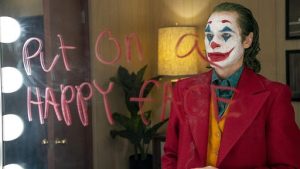64
How Class Divide Leads to Violent Anarchy in Joker (2019)
By Zach Foutch
Joker looks on as Murray and his studio audience watch his failed stand-up routine. He becomes visibly more agitated. Tonight, he had planned to kill himself, hoping that his death would make more “cents” than his life; however, watching his boyhood hero, Murray Franklin laugh at his failure, Joker decides on a different path. Everything in the past week has led to this moment, Joker has been beaten down and cast out from society. Now, his eyes are open to how truly awful people have become. His final joke will be the catalyst that causes the lower class of Gotham to rally around the clown and overthrow the elites and oppressors that have kept them down with myths of opportunity. He turns to Murray, “How about another Joke, Murray? What do you get when you cross a mentally ill loner with a society that abandons him and treats him like trash? I’ll tell you what you get! You get what you … deserve!” BANG! Murray dies and the man who was nobody, who lost his identity. Feeling abandoned by society because of his difference, he becomes a somebody.
The man who would become somebody does not start out as Joker. Rather, Arthur Fleck lives a seemingly normal life. He works as a clown for hire. He has a small and run-down apartment, but he can at least provide for himself and his mother. On the surface, Fleck works to carve out his own place in society. However, when examining his character some dark truths begin to emerge. Fleck is lonely, mentally ill, medicated, and as he explains to his therapist, “All I have are negative thoughts.” It’s no surprise then, to learn that Fleck frequently escapes his dreary life with vivid fantasies of love and support from those around him. Indeed, these stories are so encoded with realism, the viewer is left to decode the message as reality vs. fantasy.
Furthermore, his life as a clown is not a happy one. A group of students steal his sign and when he gives chase, they beat him harshly and leave him curled up in the alley, as people walk by, barely sparing a glance at him. Early on in the film, the director, Todd Phillips makes it abundantly clear that, Arthur has been shunned by society. He is different and the people of Gotham want nothing to do with him, because of that difference. Consequently, Arthur and his peers within the lower social class, face constant discrimination from the powerful elites who believe themselves inherently better than the lower echelon of society. Although Arthur is a member of the lower class, the director depicts his peers constantly shunning him because of Arthur’s quirks. Arthur is different, he has an uncontrollable laugh disorder, that causes him to break out laughing at inappropriate moments. His disorder makes those around him uncomfortable and keeps him in a perpetual state of loneliness.

The parallels between our society and that of Arthur’s are extraordinary. We cast out those we deem different for fear of opening ourselves up to discrimination for associating with the undesirables of society. Arthur is very clearly meant to represent an undesirable. He is poor, mentally ill, medicated, uneducated, and unaccepted. The point of Arthur’s constant beat downs lays the groundwork for his eventual turn into Gotham’s prince of crime. Though he is discriminated against, his difference is a much bigger focus of the movie. Arthur’s laughing disorder causes him to laugh loudly and uncontrollably at inappropriate times. It’s a major stigma to be mentally ill, mental illness is by and large, not understood by society. In fact, one of Arthur’s jokes makes a powerful statement about the difference those with mental illness feel. Arthur believes, “The worst part of having a mental illness is people expect you to behave as if you don’t.”

Much like ours, Arthur’s society expects everyone to conform to societal norms. However, the problem for Gotham and us is those norms do not allow for people that are desperately searching for help to receive that help. Too often, like Joker, the despondent forgotten people of society lash out violently at those in power, whom they feel have wronged them. For Arthur and Gotham, it’s lashing out at Thomas Wayne, the wealthy politician when he calls the people of Gotham clowns. In response to the violent murder of three employees, Wayne goes on tv calling the murderer and people like him clowns. He makes no effort to disguise the fact that the people of Gotham are beneath him. Wayne announces a candidacy for mayor and arrogantly informs Gotham that they have to follow him and that only he can lead Gotham out of economic ruin. His arrogance is predictably met with resistance from Gothamites and, as Charles Gerain states in his Joker movie review, “Gotham is torn apart by classism and societal woes as billionaire patriarch Thomas Wayne campaigns for Mayor, representing the 1% and the free-reign of the rich.”
By this point in the movie, Arthur has lost his job. His therapist informs him the city is cutting funding for social services and that Arthur will no longer have access to his meds. Quite literally, Arthur has no power, until, by a stroke of luck, Arthur finds a letter written by his mother, Penny, to Thomas Wayne. The letter claims that Thomas is Arthur’s father and suddenly, the power dynamic shifts. In this moment, it is possible that Arthur is part of the elite 1% and for a moment, Arthur allows himself to believe that salvation is at hand. Only for those beliefs to be crushed when Wayne rejects him. According to Thomas Wayne, Arthur’s mother is delusional. She invented the affair between her and Wayne as an excuse to cope with her reality. In actuality, Arthur was adopted by Penny and, as we find out, Arthur was beaten quite severely at a young age by Penny’s boyfriend. However, while the explicit story plays out on screen for the viewer, a deeper examination throws the narrative into disarray. A common theme from Phillips is that nothing is explicitly stated. It is implied and up to the viewer to make their own determination of the events in Arthur’s life.
Looking back at the Thomas Wayne is Arthur’s father storyline, while the narrative explicitly states that Arthur is a nobody, there are subtle clues that Thomas Wayne used his power and money to fabricate the entire event. It is not a stretch to believe that Wayne used his enormous fortune to forge an adoption form and had Arthur’s mother committed to hide his affair from his wife, Martha. Regardless of what the viewer wishes to believe, the story is driven by Arthur’s understanding.
We have finally arrived at the catalyst for Arthur. He is a mentally ill loner, he has lost his job, his access to medication is gone and, as it turns out, his name isn’t even Arthur Fleck. Society has constantly pushed him away, choosing to discriminate against a person they perceive to be different from them. However, Arthur has a dark secret. Unbeknownst to Gotham, Arthur is the clown who murdered Wayne’s three employees. The underclass of Gotham has taken up that symbol in protest against Wayne and the elites that seek to control their lives. Now that he is nobody, Arthur is free to be whoever he wants and what he has always wanted above all else is to be accepted and loved by society. Arthur dawns the iconic makeup of the clown and gives himself a new identity, Joker. Joker will become the symbol of Gotham’s protest, not as the head of the movement but because it’s fun, and all he wants is to have fun. Albeit, Joker’s concept of fun is twisted and dark.
Inevitably, there are those in our society that fail to understand the story Todd Phillips wants to tell. They view this movie through their narrow perspective that says everything Joker accomplished was due to his whiteness. They confirm their bias when refusing to contemplate and understand what this movie actually is. For example, Lawrence Ware of The New York Times writes, “what struck me most is what the film wants to say-about mental illness or class divisions in American society is not as interesting as what it accidentally says about whiteness. For it is essentially a depiction of what happens when white supremacy is left unchecked. It shows the delusions that many white men have about their place in society and the brutality that can result when that place is denied. The fact that the Joker is a white man is central to the film’s plot. A black man in Gotham City in 1981 suffering from the same mysterious mental illness as Fleck would be homeless and invisible. He wouldn’t be turned into a public figure who could incite an entire city to rise up against the wealthy. Black men dealing with Fleck’s conditions are often cast aside by society, ending up on the streets or in jail.” Lawrence Ware utterly fails to comprehend what the Joker narrative is intended to be and instead, turns the movie into a racial issue. Ware believes Joker is an example of white supremacy and that the difference, power, and discrimination present in this film are products of race. He ignores the obvious implications of classism and the story of how society reacts when oppressed by elites that look down upon them. The lower echelons of society are meant to be followers, subservient to our leaders, the elites, the 1%. Whether intentional or not, Todd Phillips has painted a vivid picture of what is happening to our own society. Our own society is struggling with an imbalance of power and wealth. In fact, the extremely wealthy, continue to become richer, while the rest of us struggle to meet the demands of day to day life.
Joker tells the story of what happens when a society is pushed to the brink. The lower class is choking under economic pressures and inability to care for themselves because the jobs they rely on are disappearing. Their problems are capitalized when the wealthiest man in Gotham calls them clowns and instructs them to follow him, as he is their salvation. Like Gotham, our society has experienced rapid economic growth that disproportionately benefits the upper class. According to Reuters, our society is struggling with the fact that the wealthiest fifth of Americans hold 88% of the country’s wealth, while the number of people receiving foods stamps has gone up to 39 million, a 40% increase from 2008. Joker personifies our society, showing us what happens when a person pushed to the brink can become.
While Joker lashes out and seeks to become a bully for fun, he unintentionally becomes a rallying point for the disillusioned lower class of society that is fed up with the status quo. That his outbursts become violent is simply a by-product of his desire to be heard by society. Now that he understands how truly awful society is, Joker gleefully goes on a rampage bullying those who have bullied him. He seeks retribution and will stop at nothing to avenge himself. If people die, so be it.
References
Brown, Elizabeth Nolan. “Everyone Is Getting Joker Wrong.” Reason.com, Reason, 8 Oct. 2019, reason.com/2019/10/08/everyone-is-getting-joker-wrong/.
Debney, Ben. “Liberals, Class and the Joker Complex.” CounterPunch.org, 6 Oct. 2019, www.counterpunch.org/2019/10/11/liberals-class-and-the-joker-complex/.
Gerain, Charles. “Review: JOKER Is Disturbing and Captivating.” Blackwell Journal-Tribune, Service Blackwell & Kay County since 1915, 14 Oct. 2019, www.blackwelljournaltribune.net/articles/10993/view.
Hunnicutt, Trevor. “Rich Get Richer, Everyone Else Not so Much in Record U.S. Expansion.” Reuters, Thomson Reuters, 2 July 2019, www.reuters.com/article/us-usa-economy-expansion-contrasts/rich-get-richer-everyone-else-not-so-much-in-record-u-s-expansion-idUSKCN1TX0HE.
Ware, Lawrence. “The Real Threat of ‘Joker’ Is Hiding in Plain Sight.” The New York Times, The New York Times, 9 Oct. 2019, www.nytimes.com/2019/10/09/movies/joker-movie-controversy.html.

